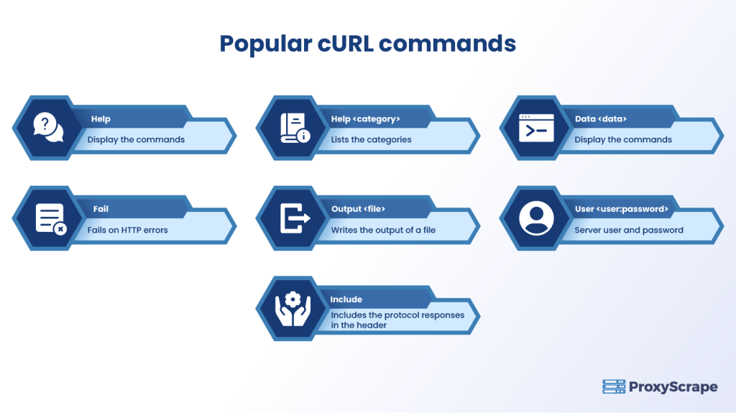CURL Proxies – An Ultimate Guide of 2025

According to Statista, in 2022, more than 66% of the world’s population is using Internet media and involved in internet communication. Communication is the major application of networking. People tend to send and receive information from one server to another server connected to the network. Out of multiple ways of establishing communication, here we have
According to Statista, in 2022, more than 66% of the world’s population is using Internet media and involved in internet communication. Communication is the major application of networking. People tend to send and receive information from one server to another server connected to the network. Out of multiple ways of establishing communication, here we have the model of passing information to a server through commands. Wouldn’t it be great, if users added proxy features with command-line communications? This article will guide you to configure curl with a proxy server and explain how a proxy could support cURL commands when accessing blocked sites with high-level security.
Table of Contents
- What Is cURL?
- Why Do We Need cURL Proxies?
- How to Use The cURL Command?
- Using a Proxy with cURL Commands
- Proxy Authentication
- Bypassing SSL Certificate Errors when Using cURL Proxies
- Environmental Variable
- Using Alias
- Ignore a Proxy for cURL Requests
- Socks Proxy Server
- cURL Proxy by Proxyscrape
- Also, Read
- Frequently Asked Questions
- Conclusion
What Is cURL?
A cURL is a command-line tool that is responsible for transferring data in the network. A command line is a process of instructing the Operating System through commands. In the same way, this cURL tool allows users to pass information to servers on the internet through simple commands.
cURL is considered one of the best command-line tools because it supports most communication protocols, like HTTPS protocol, HTTP, FTP, Socks, and SFTP. cURL commands have this special feature of configuring with proxy servers. This hides the actual IP address of the user’s commands and uses the proxy address for the communication. The cURL tool is compatible with all types of Operating Systems. The versions after Windows 10 can use this with command prompts, while others will use them after downloading the cURL software.
Why Do We Need cURL Proxies?
The cURL commands that help send and retrieve information online may face IP blocks or geo-blocks in certain cases. There may be some sites that geographically block users from getting or posting data from their URLs in other locations. The proxy server uses its proxy address to work across geo-blocks and reduces IP bans. Users can configure proxies with HTTP requests. Likewise, configuring proxies with the curl commands is also possible. These cURL proxies allow users to make use of proxy features and secure protocol requests. The cURL proxies use the HTTP proxy, allow it to authenticate the proxy, use environment variables, add an alias, and use proxies for the required sites. Proxyscrape has a wide range of proxy options for users that support securing the protocol requests.
How to Use The cURL Command?
Some Operating Systems, like Linux, and MAC. And versions like Windows 10 allow you to use cURL directly with the command prompt. Other Operating Systems require proper installation of cURL to start working with it.
- For window’s older version, download the cURL software from this official download page.
- For Ubuntu, open the ‘terminal’ and run cURL using the cURL install command.
sudo apt install curl
The Help Command
One important command among many cURL commands that everyone should know is the ‘help’ command. Here are the steps to use the help command.
- This command line lists the syntax and uses of all available cURL commands.
curl -- help
- This command displays a list of the attributes and their syntax. But, this command does not display all the commands. The cURL has multiple categories of menus. You can list the categories and view the required help menu.
curl --help category
- As shown in the figure, this category command lists all available command categories in the cURL.
- Among them, find the one you need and use that category name in the help command.
curl --help proxy
- This command displays all commands related to the proxy.
Popular cURL Commands
Here are some popular commands and their syntax.

Popular commands – Curl Proxies
| –help | Displays the commands |
| –help | Gets help |
| –data | HTTP post data |
| –fail | Fails silently on HTTP errors |
| –include | Includes the protocol responses in the header |
| –output | Writes the output of a file |
| –user | Server user and password |
Sample Examples
Here, let’s discuss a few simple examples of cURL commands.
Every cURL command starts with the word ‘curl’ which is followed by the actual instruction to the system from the cURL command-line tool.
Example:
curl https://www.proxyscrape.com/home
This displays the HTML code of the page.
curl https://www.proxyscrape -I
This command displays the header information of the website.
Using a Proxy with cURL Commands
Users can configure the default proxy protocol with cURL requests. This lets users access information anonymously. Here is the cURL command-line to set up a proxy in a cURL request.
curl --proxy [protocol://]host[:port]
Example :
curl --proxy http://159.65.133.175 https://www. httpbin.org/ip/
In this example, we are configuring the proxy server of our localhost with the HTTPS request to access the desired URL.
In this case, we are using two URLs. The first one is the proxy address (http://159.65.133.175) that we are configuring with the HTTP request. The second one (httpbin.org/ip/) is the URL that we wish to access with the proxy address.
Now, this HTTP request is secured with the proxy settings.
If you want to explore other commands related to this proxy, use the help command with the proxy category.
curl –help –proxy
Proxy Authentication
Users can also include authentication to HTTP proxy servers. The authentication cURL command begins with the –U flag and further proceeds with the username and password attributes to ensure security.
Here is the basic syntax of the authentication command:
curl -U --proxy-user <user:password>
Example:
curl --U user: password --proxy http://159.65.133.175 https://www.httpbin.org/ip/
If the password contains any special characters, make sure to enclose it with double quotes.
curl --U "user: P@ssword" --proxy http://159.65.133.175 https://www.httpbin.org/ip/
If the user is not ready to pre-define the password, they can just include the “user” variable and leave it without adding the password as shown below. Running this command prompts the user to enter the password while executing commands.
curl --U user --proxy http://159.65.133.175 https://www.httpbin.org/ip/
Explore other authentication commands using the “help” command.
curl –help auth
Bypassing SSL Certificate Errors when Using cURL Proxies
Proxy users mostly prefer cURL proxies for debugging purposes because cURL proxies can effectively handle security errors with a –k flag. SSL certificate errors may reject HTTP requests if it finds them not secured. In this case, the HTTP proxy with cURL commands uses the –k flag to ignore the security errors.
curl --U user: password --proxy http://159.65.133.175 https://www.httpbin.org/ip/ -k [URL]
Environmental Variable
People can use environmental variables with proxies. Users can define environment variables for each protocol they use. If they use HTTP protocols, they can define an HTTP proxy address to the variable names “http_proxy” or “https_proxy.” Whenever there is a need to use the HTTP proxy server, the users can make use of this global proxy without specifying the proxy URL each time.
Example:
export http_proxy="http://159.65.133.175"
export https_proxy="http://159.65.133.175"
Using Alias
Using the alias command is another simple way of permanently configuring proxies. In this case, users can configure a proxy command to another proxy command.
alias curl= "curl -x http://159.65.133.175"
Here, the word “curl” in the command is defined with another command line “–x http://159.65.133.175.”
Example:
curl https://www.httpbin.org/ip/
In this sample, the word “curl” in the command refers to the HTTP cURL proxy. The actual meaning of the command-line is similar to the command shown below.
curl --proxy http://159.65.133.175 https://www.httpbin.org/ip/
Using Curlrc File
Here is another simple way of configuring a proxy server to avoid passing it each time. By creating a cURL configuration file (.curlrc file), users can create a home directory and include multiple proxy configurations.
Example file: .curlrc file
proxy = "http://159.65.133.175"
Ignore a Proxy for cURL Requests
People may need to bypass proxies manually for certain cases, though they have set proxies globally through cURL features, like environment variables, aliases, or cURL files. In this case, you can use the –no proxy command to bypass the proxy address.
curl --no proxy "*" https://www.httpbin.org/ip/
Socks Proxy Server
As we already know the cURL command supports most of the protocols, here we have an example with the socks protocol. Here we use a socks proxy instead of the HTTP proxy, which we have discussed so far.
curl --socks5 "159.65.133.175" https://www.httpbin.org/ip/
People can include user authentication for the socks5 protocol.
curl --socks5 "159.65.133.175" https://www.httpbin.org/ip/
cURL Proxy by Proxyscrape
Proxyscrape is one of the best proxy vending solutions that furnish residential proxies, data center proxies, and dedicated proxies. People can make use of proxies from Proxyscrape to configure them with the cURL commands. As these proxies are geo-specific and are available in different protocols it is the best fit for cURL proxies to use with sites of different protocols and locations. Check out the pricing package of proxies.
Also, Read
What is a proxy switcher and how does it work?
How to test a website using a proxy?
Why are proxies for cyber security so famous?
Frequently Asked Questions
FAQs:
1. What is the cURL command?
2. In what way proxies can help cURL?
3. What does the “cURL include” command do?
4. What does the IMAP protocol category of the cURL command do?
5. How to use a proxy with the cURL command?
Conclusion
Passing information to and from websites through the command-line tool is the basic ideology of cURL commands. If you wish to secure cURL commands with proxy features, like scraping ability, anonymity, and other debugging services, try a default proxy server to run on your device and configure it with cURL. Use help commands to learn more about cURL command-line arguments.